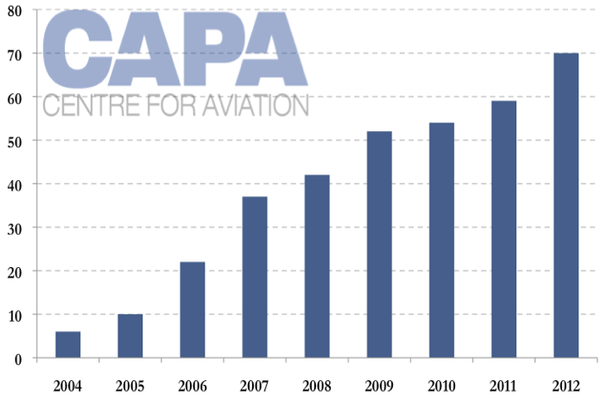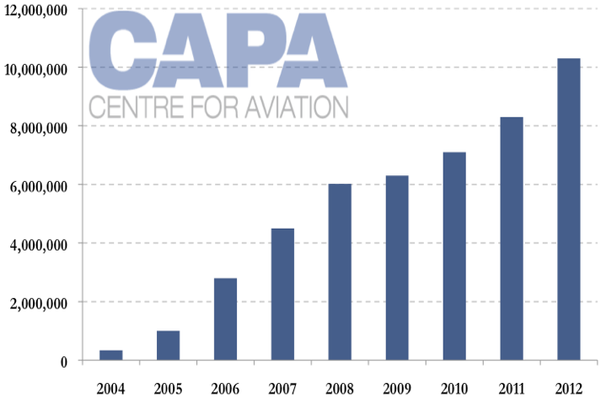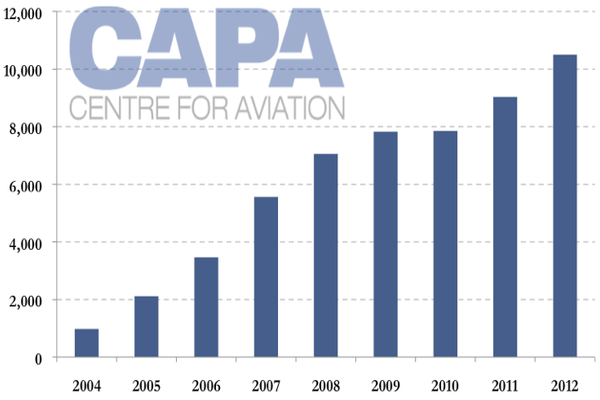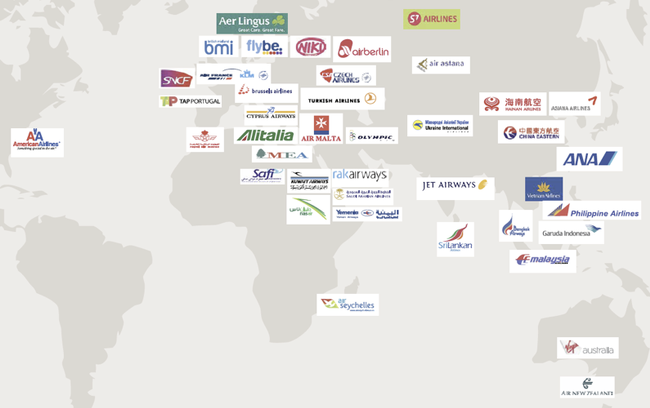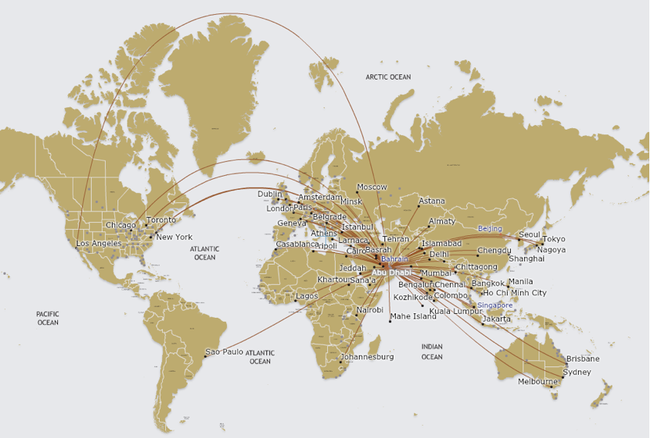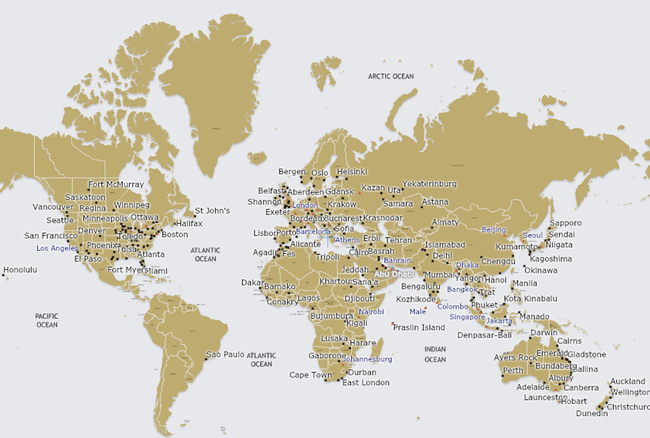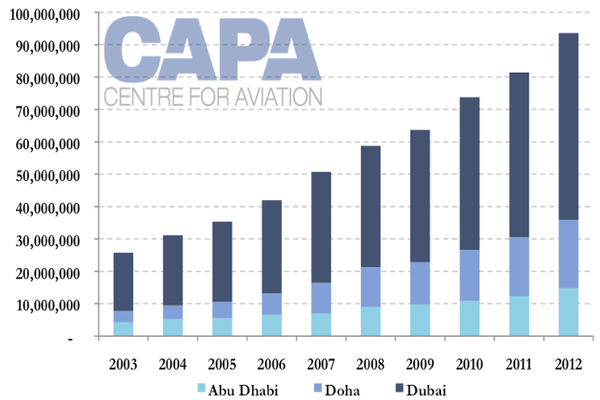Etihad reaches a decade, and helps transform global aviation
On 12-Aug-2013 a historic milestone rolls around, when Etihad Airways turns 10 years old. The carrier, which proudly advertises itself as the fastest growing airline in the history of aviation, has helped usher in a revolution that has reshaped the global airline industry.
Etihad Airways was born as the national airline of the UAE via a Royal Decree issued in Jul-2003. Less than six months later it began operations, with just one aircraft. It launched itself in the midst of a major shake-up of the Middle East's market and with a mission to support the development of Abu Dhabi as a business and leisure destination and help realise the transformation of the city into a global hub.
A decade on, Eithad Airways has achieved its objectives. Through a combination of rapid organic growth, aggressive partnership development and innovative equity acquisitions, the carrier has become one of the headline players not only in the Middle East, but in global aviation. Few carriers can boast such success in such a small amount of time. Fewer still can claim to be part of a revolution that is helping to change how the world connects.
Since it first took to the skies, Etihad has undergone phenomenal changes, not only in size, but also in its outlook, its strategy and its regional and global influence. From one destination at launch, it now has operations to six continents and has carved out, in the words of its CEO James Hogan, a "global brand", that lines up with Abu Dhabi's goal of creating a distinctive tourism identity. The carrier has also made a commitment to provide passengers with a superior travel experience both inflight and on the ground.
Etihad is the newest, smallest and fastest growing member of the "Big Three" club of Gulf sixth freedom hub carriers. Along with Qatar Airways and Emirates, based just 120 km away in Dubai, Etihad Airways has parleyed a combination of geographic advantage, a favourable regulatory regime and public sector investment, along with modern aircraft technologies and new business strategies to challenge the established order of legacy airlines and global alliances.
Small beginnings and big ambitions
Etihad was founded with a clear but ambitious mandate to be safe, be profitable and be the best airline in the world, all while fulfilling a role as a key enabler in the transformation of Abu Dhabi into a world-class trade and tourism centre. These were weighty goals for an airline that started operations with a simple hop from Abu Dhabi to Al Ain, a distance of just 145 km.
In its first year of operations, the airline hardly set the aviation world ablaze. It handled a little over 340,000 passengers, operating to mostly regional destinations. Traffic built quickly but not particularly remarkably through the next few years, as Etihad ordered new aircraft and added destinations to its network.
During the start-up phase, Etihad operated at a loss. It had added 24 aircraft and 40 destinations in under three years, an impressive achievement by any standard. However, passenger load factors were low, yields were poor and the airline was suffering from undercapitalisation, curtailing its financial flexibility. However, it also had the strong support of the Abu Dhabi government and along with it the Abu Dhabi Airports Company.
The carrier really announced its arrival as a major player in 2004, when it announced orders for 29 aircraft, including five long-range Boeing 777-300ERs and a mix of Airbus aircraft, including four A380s. This was just a taster of the carrier's ambitions though. At the Jul-2008 Farnborough International Air Show, Etihad Airways announced it was purchasing 100 aircraft, along with 55 options and 50 purchase rights, in what was then the largest aircraft order in commercial aviation history.
It was the clearest indication that the airline was not only interested in expansion, but a pace of growth that had never been achieved by a major international airline before.
Etihad Airways fleet expansion: 2004 to 2012
Management leads the transformation
Another major turning point came on 10-Sep-2006, when the airline signed James Hogan as president and CEO. A 30-year airline and tourism veteran, Mr Hogan had a wealth of experience in the airline industry as well as the Middle East market, both as an airline executive and outside the industry.
Mr Hogan brought with him a new management focus and change in the way Etihad Airways went about its business. At the onset of his tenure, his directive was to financially restructure the carrier, moving it out of the start-up phase and developing the airline into a mature business that could operate as a purely commercial entity, without help from government subsidies. Senior management's mission was also to grow and achieve scale quickly, introducing sustainable business processes and systems.
The 2007 business plan devised by Mr Hogan and his management team envisioned not only continuing the rapid growth that Etihad had generated to that point, but building it into a mature, profitable carrier that would meet the mandate bestowed on it. Executive VP finance James Rigney, who had followed Mr Hogan from Gulf Air, set about recapitalisation of the carrier with the Abu Dhabi government. An operational break-even goal was set for 2010, with profitability to follow from 2011.
Eight years on from Mr Hogan's move into the carrier's top job, the change wrought at the airline has been remarkable. Despite some setbacks, Etihad Airways reached its break-even and profitability targets, and is heading for its third consecutive profitable year. The carrier has a "forensic" focus on costs and according to Mr Hogan, has a "management culture is that of a low cost airline."
Etihad Airways financial highlights (USD million): 2011 and 2012
|
Year |
Revenue |
Net profit |
EBIT |
EBITDAR |
|---|---|---|---|---|
|
2011 |
4.1 billion |
14 million |
137 million |
648 million |
|
2012 |
4.8 billion |
42 million |
170 million |
753 million |
It is consistently recording passenger traffic and revenue at double-digit rates, now handling better than 10 million passengers per annum and generating better than USD1 billion per quarter in revenue.
Etihad Airways passenger traffic: 2004 to 2012
By the end of 2012, Etihad had carried a total of almost 47 million passengers. For 2013, it expects to carry another 12 million. By 2020, Etihad Airways plans to carry more than 25 million passengers per year to more than 100 destinations aboard a fleet of 150 aircraft.
The carrier is a major contributor to the economic health of Abu Dhabi. It directly employs more than 11,000 staff - of which more than 20% are Emirati nationals - and in 2012 its direct and indirect contribution to the Abu Dhabi economy is estimated at USD10.7 billion. The carrier projects this will increase to USD19.3 billion by 2017.
Etihad Airways workforce: 2004 to 2012
The third way - Etihad and its "Equity Alliance"
Better than 80% of the world's international air traffic is now handled by one of the three major international airline alliances; oneworld, Star Alliance and SkyTeam. The chief advantage of alliances are their ability to offer 'from anywhere to anywhere' service. Only a few major carriers still operate outside of the alliance system.
Of the Big Three in the Middle East, two - Emirates and Etihad Airways - have so far remained conspicuously absent from the alliance network. Qatar Airways joined oneworld, the loosest and largest of the alliances, at the end of Oct-2013. Emirates sees the alliances as profoundly anti-competitive and prefers bilateral agreements only. With better than 200 aircraft and more than 160 destinations in its network, it is also one of the few airlines that has sufficient mass to favour going it alone, admittedly along with a few bilateral relationships in key markets.
Etihad Airways has chosen a third way. It is unwilling, at least for the present, to hitch its wagon to one of the alliances. But nor is it willing to go it alone, in the face of the strong competition it faces from its neighbouring hub carriers as well as those airlines that it faces at the end of its networks.
To build the kind of 'from anywhere to anywhere' service that the alliances offer, Etihad Airways has accumulated a broad and deep network of partnerships. Over the past five to six years, it has signed interline agreements and codeshare relationships with 46 partners and set up revenue sharing arrangements with airlines and even rail companies.
Etihad Airways codeshare partners (2012)
By doing so, it has created an arrangement of relationships that dramatically expand its international reach, providing it with behind gate access in major domestic markets such as the US, Canada, Australia and Japan which it would not normally enjoy.
However, Etihad has not stopped at just codeshares and interlining. The airline is also pioneering a new business concept, that of the 'equity alliance', an amalgam of international airlines centred around the UAE carrier and bound together by minority equity investments from Etihad. Not only does this grouping allow the carrier to compete with its older and larger GCC competitors, but it also allows it to stay aloof from the alliance system.
Etihad now has an alliance of five equity partners - Virgin Australia, airberlin, Air Seychelles, Air Serbia (formerly Jat Airways) and Aer Lingus. It is also awaiting final sign-off from Indian regulators before it can add a sixth member, in the form of Jet Airways, in the biggest deal for Etihad to date. The USD330 million dollar deal will be the first investment by a foreign carrier in an Indian airline since India relaxed its foreign ownership regulations in 2012.
Etihad has mostly seized low hanging fruit when it has come to building its relationships. With the exception of Virgin Australia, all the carriers it has invested in were loss making at the time of the deal. In the cases of Air Seychelles and Air Serbia, it has bailed out failing, government owned carriers, leveraging the cooperation and support of the controlling national governments to help refund the partner, as well as investing its own managerial expertise.
For Etihad, the benefits come as it gains access to a vastly expanded virtual network and fleet. Under its own power, Etihad has a fleet of around 85 aircraft and a little under 100 destinations.
Etihad Airways route map (Nov-2013): Etihad Airways operations only
With its equity alliance and codeshare partners, the carrier can further boast access and additional 375 destinations, serviced by a fleet of approximately 500 aircraft.
The equity alliance partners it has selected provide strong beyond-gateway connectivity - Etihad codeshares with airberlin to 45 cities in Europe, with Virgin Australia to 44 destinations in Australasia and with Aer Lingus to 18 destinations.
Etihad Airways route map (Nov-2013): Etihad Airways and codeshare partners
The equity partnerships also generate solid amounts of revenue and traffic. In 3Q2013 revenue from codeshare and equity alliance airline partners accounted for USD247 million. This was 23% of Etihad's quarterly passenger revenue and alliance income is expanding faster than organic revenue growth.
For the partners, the benefits of the alliance are also substantial. They enjoy joint procurement of assets, services and supplies covering major items such as aircraft, engines, fuel and insurance, as well as cooperation on issues such as maintenance. Etihad provides crew training and joint sales activities, linked frequent flyer programmes, shared lounge access.
There are also codeshare opportunities within the equity alliance, among "members" - for example Air Seychelles now codeshares with airberlin, while Air Serbia entered a codeshare agreement with airberlin in Jul-2013.
Another intriguing - but still unannounced - strategy surrounds Etihad's acquisition of large interests in some of its partners' Frequent Flyer Programmes, replete with data and loyalty potential. The philosophy behind this has not been elaborated, but there is a growing store of data to which Etihad has access.
Etihad Airways will continue to pursue its independent strategy. Mr Hogan has said there is "ample evidence to show that the traditional airline model and legacy airline alliances are no longer relevant to today's operating environment". He believes the Etihad Airways strategy is the way forward for global aviation.
A symbol of the Middle East's rising importance in global aviation
Etihad Airways' development over the past 10 years is symbolic of the wider development of the Middle East as a new centre for global travel. The year Etihad Airways launched its first flight, the three major transit hubs at Abu Dhabi, Dubai and Doha handled combined international traffic of a little under 26 million passengers, more than 70% of which was handled at Dubai.
Middle East sixth freedom hubs passenger traffic: 2003 to 2012
Ten years on and the combined traffic at the three airports has almost quintupled, reaching 93 million at the end of 2012. Dubai's share of this traffic has fallen to around 60%, even as it has grown rapidly. This year, traffic at the three main Middle East hubs will better 100 million passengers.
Rapid expansion, for Etihad Airways, as well as for Qatar Airways and Emirates, will be the continuing story for the immediate future. The three Gulf carriers have better than 420 aircraft on order, of which more than 350 are long-range widebody aircraft. On the ground, there are massive infrastructure developments, such as the newly opened to passenger traffic Al Maktoum International Airport and the soon to be opened New Doha International Airport, designed to satisfy infrastructure requirements for decades to come.
What began with the Gulf carriers linking the passengers between Europe at one end and Asia-Pacific at the other has been transformed. With partnership, alliances and equity acquisitions, the Gulf carriers have developed truly global networks, linking all continents to hundred of destinations with just a single stop in the Middle East. More so than any other region, the Middle East is setting the trend for international travel.
Ten years on, Etihad with its remarkable organic expansion, followed by a strategy of linking closely with selected foreign airlines, is potentially forging a new model of core airline. In this its operating role is now sufficiently large to allow it to provide an efficient platform for other airlines to use as a springboard - surely the direction that a more effective future airline system must adopt.
The value of its novel equity purchases is yet to be proven as a concept that is durable and effective. Attempts in the past have usually met with less than great success. But timing is always critical and today's world offers new opportunities; certainly to date the concept appears to be bearing solid results, over and beyond those that would flow from merely codesharing.
By the time the airline industry is 10 years older, it is interesting to speculate on the companies that will be successful in this new environment. Barring remarkable reversals of fortune, it would have to be a strong probability that Etihad will be one of the biggest airlines in the world.
